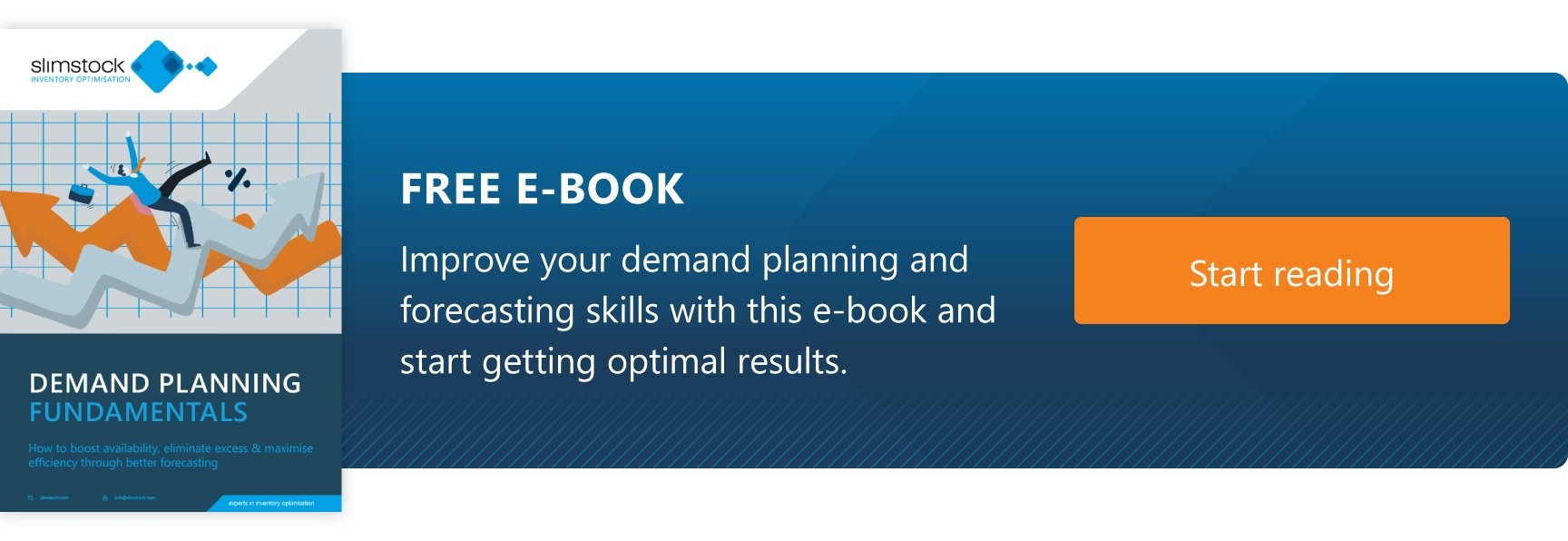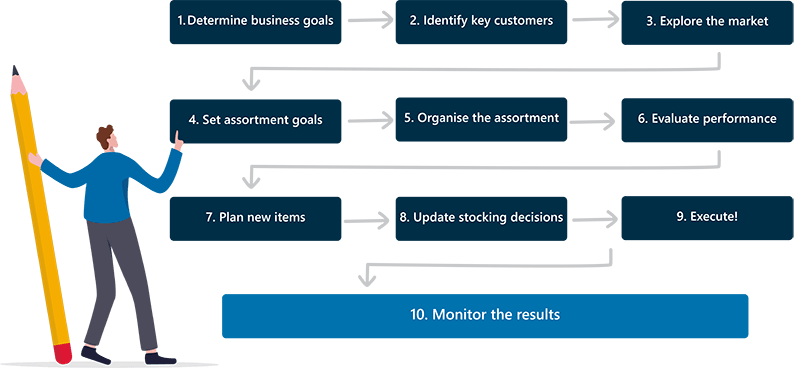Table of contents
Table of contents- Assortment planning: Definition, examples and a 10-step checklist
- Assortment planning: the only checklist you’ll ever need
- You need to learn when to say no
- So how can you ensure your assortment plan makes sense?
- What is assortment planning?
- Here’s a handy assortment plan template to get your started
- Put your assortment plan into action!
- Assortment planning tips ‘n’ tricks
- Where can I find the assortment planning rule book?
- What’s the ‘right’ way to Phase-in & phase-out products?
- What other assortment management complications do you need to worry about?
- Assortment planning takeaways
- Assortment planning FAQs
Assortment planning: the only checklist you’ll ever need
“Variety’s the spice of life,” they say. And in the material world, trying to satisfy every whim and wish of your customer seems like a sound product assortment planning.
Everyone loves a choice.
Offering that choice means you’ll always have custom.
How much ice cream do you think a shop would sell if they only stocked vanilla? No disrespect to vanilla by the way. That flavour does a lot of unnoticed heavy lifting.
But you can make the same point about your approach to assortment planning. How do you think your sales numbers would look if you only offered one product
Imagine you were responsible for apparel assortment planning and you sold shirts. However, you only had one shirt, in medium, in black.
Or what if you business was in the furniture trade and stocked just one cabinet, strictly for drinks, in pine.
Your sales potential would be capped, to say the least!
Equally, you can’t offer the world.
And you shouldn’t assume the sky’s the limit with your product assortment. Just as an ice cream parlour wouldn’t stock every flavour known to man, you can’t stock every little thing your customer might want.
Even if you’re Tesco. Do you think their purchasing department says yes to every pitch?
You need to learn when to say no
It’s a powerful word.
Use it correctly and it can make a huge difference to your business. The trouble is, many don’t know how to wield it, and even worse, when to.
And so seemingly small decisions like “Hey, should we buy a few tubs of rum n’ raisin? Someone just asked for it…” might get given the go-ahead, because they’re easy yeses to give.
Before long though, you’ve got 35 different flavours, with 30 tubs of each, all needing freezer space, despite the fact you only sell 3 flavours regularly.
But here’s the problem.
Whether you’re Ben and Jerry, or sell sherry to ferries, the issue with large assortments is the huge amounts of money, inflated man-hours and increased stress of keeping things in check.
So how can you ensure your assortment plan makes sense?
Reading this guide would be the perfect place to start. And from there?
Well, there’s a helpful assortment planning download at the end of this article to keep you on the straight and narrow.
But let’s start with the basics.
What is assortment planning?
Your assortment is a treasure trove of value. Get it right and your on to a winner. But get it wrong and you will be in a world of pain.
So, clearly assortment planning is important. But what is it?
In short, assortment planning is the process of determining which products to offer to meet the needs of your customers.
However, effective assortment planning should be a strategic process whereby you analyse the performance of products within your current range, review customer wants and determine which products you need (or subsequently don’t need) to hit your business goals.
Sounds easy, right?
Deciding which products make the cut is an important decision. Sure, there are lots of data points you can consider to make an informed choice. But there is often lots of emotion involved!
We also can’t ignore that each team will have different idea about what a ‘good’ product assortment should look like.
Perhaps your finance team demand a product assortment that yields strong margins with minimal risk.
Sales & marketing, on the other hand, may want a vast selection of items to satisfy their customer’s every want and need.
And then we need to consider that the assortment offered at the central distribution centre is likely to be very different to the assortment on offer in each local branch.
What’s your product assortment strategy?
What’s your business strategy for product assortment decisions? And if you don’t have one, why don’t you?
There’s no chance of you making good choices without a clear strategy. And merely weighing up a product when you have the chance to stock it won’t cut the mustard.
That’s not an assortment strategy. It’s a reactive scramble.
Your entire approach to range & assortment planning must support your wider business ambitions.
For example:
- Do you want to be a one-stop-shop for everything under the sun?
- Do you want to set the industry standard in quality?
- Do you want to lead the way in fast, dependable delivery?
- Do you want to be the cheapest option in the market?
All options are valid. But you can’t pick them all.
Your answers to the questions above can help shape the size, scale & depth of your product assortment.
And obviously the wider business strategy along with it.
A good product assortment strategy is like a good joke
It’s all about timing. And delivery’s the most important part.
But here’s the thing. Just like you can’t tell a joke everyone will like, you can’t be all things to all people. And there are some people, namely your top customers, who are worth pleasing, even if it displeases others.
Here’s a handy assortment plan template to get your started
We have said it before, and we will say it again; the assortment planning process is just that.
It’s a process.
That means to build a robust assortment plan, there are some logical steps you need to think about.
Let’s dive into each step one by one.
Step 1: Determine the business ambitions & goals.
The business vision should be the driving force behind all assortment decisions.
Regardless of if the business wants to cut costs or diversify into new markets, your product assortment should be a direct reflection of the wider business goals.
Step 2: Identify your key customers
It’s important that your product assortment meets the needs of your customers.
But should you worry about the customer that only buys a few items from you once or twice a year? Or should you focus on the customers that buy from you every week?
This is a question that only you can answer.
If you take some of the internet giants, assortment planning for e commerce environments probably requires a greater emphasis on the needs of the occasional buyer.
Afterall, how else can these companies grow market share?
On the other hand, in industries where the customer-supplier relationship is more intimate, you probably need to put your best customer first.
Step 3: Explore the market
Your product assortment is your competitive differentiator. So can you afford to make assortment planning decisions without considering what your industry peers are doing?
What products do your competitors offer? More importantly, what products are missing from their assortments?
Step 4: Set your assortment goals
The decisions you make about your assortment could well shape the future of your business. Therefore, it’s important that you define what you hope to achieve as well as logical measures to track if these assortment goals have been hit.
The goals must relate to the business ambitions (see step 1). But here are some product assortment example objectives:
- Generate a target level of revenue
- Reach a certain level of order lines within a given window
- Contribute a target percentage of profit margin
- Secure 5-star customer satisfactions rating
- Maintain availability in excess of a certain level
Top tip: There are lots of KPIs you could measure. But its best to focus on the ones that matter most. Check out our handy guide to smart KPIs to find out more.
Step 5: Organise your assortment
How many SKUs can you plan effectively? Chances are, not many!
By grouping your assortment into logical categories, you can plan your assortment with far greater efficiency.
The other, often overlooked, benefit of segmenting your product range into categories is that you can yield much richer insights. For example, you can review the performance of each product group and even how each item within it performs with greater clarity.
Step 6: Evaluate your current performance & identify the gaps
Before we jump in headfirst, it’s probably best to take stock of where we are today. Afterall, there is little point in changing your product assortment strategy until you understand which bits work and which don’t.
The result of this analysis should allow you to answer questions like:
- Which products add value? And which items just cost us money every month?
- Do you really need to offer another variant of a product that is already underperforming?
- Which product categories are exceeding expectations & which need attention?
Step 7: Anticipate the potential of new items
It’s easy to look back at your existing assortment and review the data. You know which products sold well. More importantly, you can see which product fell short of expectations.
Demand planning for new products is a little trickier. You don’t have the data. There are lots of unknown. Therefore, you may need to take a hunch at how well the new items in question will sell.

But that doesn’t mean you have to put a finger in the air and hope for the best.
You can ‘borrow’ sales data of similar items that you already stock to make an educated guess at what the future might bring.
You could even gather market intelligence from your sales team or directly from your target customers.
The point here is that it is possible to make sensible projections for new items without needing a crystal ball.
But it’s also important that you track the trajectory of new items to see if your presumptions become a reality. We will revisit this later.
Step 8: Update your stocked vs non-stocked-decisions
You have done all the number crunching. Now, it’s time to make the call. But which products should stay? And, which products should go?
It’s important that this is a rational decision.
And not merely based on gut-feel or who shouts loudest.
Step 9: Execute your assortment plan
The next step is to put you plans into action. What does this mean?
Well, it means placing orders with suppliers, allocating inventory throughout your network and optimising replenishment to fulfil customer demand with vigour!
Step 10: Monitor the results
To move forward, we sometimes have to look backwards.
This means revisiting your assortment decisions and seeing if your expectation became a reality.
We have mentioned the importance of the performance review for new items. But you cannot afford to ignore those items already established within your assortment.
Things change, your customer’s expectations shift.
Maybe your competitors caught on and found a new way to innovate, or perhaps a newer version of the same product has been released to the market.
Either way, this final step should inform all your future assortment planning decisions.
Put your assortment plan into action!
In theory, this hopefully all seems logical.
In practice however, there are obviously lots of levers you need to pull. And, no doubt, you may need to have some difficult conversations along the way.
But worry not!
In the next section, we will cover some tips, tricks, and industry best practices to help you plan your assortment like a pro!
Assortment planning tips ‘n’ tricks
Are your product assortment objectives reviewed every month?
Great question!
So far, we have talked about assortment planning as a linear process. However, in practice, you and your team should be working on the assortment strategy every single day.
Whether this means reviewing last months sales figures or speaking to suppliers about the next big product launch, assortment planning should be a dynamic entity within your wider supply chain process.
Afterall, as we’ve seen in the last few years, things can change quickly.
Therefore, your assortment strategy must keep up with your business.
Every month, your assortment strategy should be assessed to see if it still meets the demand of not only your customers but your bank balance.
Where do you draw the line on your product assortment?
Everyone has restrictions. And so does every business. Working out what yours are, will make your assortment planning decisions a lot easier.
Due to the simple fact, that you don’t have unlimited warehouse space, you’ll be restricted to a maximum number of items you can stock at any one time.
Your SKU count can’t grow infinitely and there’s always a point where a line in the sand must be drawn.
But limiting your products per category will ensure focus and prevent stock cannibalisation. That is, a new product is being introduced which limits the sale of an existing item. Like the drip who runs the ice cream shop above.
When it comes to assortment planning, it’s imperative to have a clear set of rules for which items should be stocked and which shouldn’t be. And when these introductions should take place.
- Have you accounted for seasonal changes?
- Are you hindering the power of a loss leader?
- Are you keeping track of market trends?
- Is a new product a diversion from your traditional business? Or does it complement the existing portfolio?

Where can I find the assortment planning rule book?
To make logical & informed stocking decisions, you need a clear set of guidelines.
And you need a rulebook.
Off course, this can’t be a one-size-fits-all playbook. The rules that guide your assortment depend on your market, your goals and, of course, your customers.
But ultimately the parameters that use to guide your assortment plan should provide logical answers to difficult questions. For example:
- What’s the strategic importance of the product to your overall goals?
- Is it crucial? Or is it an add-on which might create a negative outcome at the end of the year?
- What is the risk & impacts of stock-outs?
- If you sell to trade, is the importance of getting your stock might be woven into the success of their business too?
- Can they wait? And if so, how long will they be willing to wait until they continuously shop elsewhere?
- How quickly can your supplier respond to changes in demand?
By reverse-engineering your answers to these questions, you can create a rulebook by which to measure stocking decisions.
What’s the ‘right’ way to Phase-in & phase-out products?
At some point, your products need phasing out. Just like you’ll need to introduce new items, so current ones will die in relevance. There are a hundred reasons why it might happen.
But it will happen.
And you need a plan in place.
For example, when products are no longer profitable, are they immediately phased out? Leaving detection of a decline to chance could mean you’re left with obsolete stock.
Likewise, is there a clear process for updating the assortment based on the updated stocking decisions?
There’s always lots of excitement around a new product launch.
But, when it comes to dropping a product line, it can be viewed as a failure. Questions are asked from above and no one wants to claim responsibility.
It’s as easy to get carried away and launch a rum n raisin flavour no one wants, as it is to bury your head in the sand when it’s time to retire raspberry ripple.
But it’s far more complicated for most than running a two-person ice cream parlour. You’ve got Sales, Marketing, Management, Ops, Finance and C-suite to please and they’ve all got different questions and motives.
A solid process removes emotion and makes sure the key criteria fit the business as a whole.
But the first question we need to ask is: Who’s in charge here?
It’s easy to pass the buck on difficult assortment planning decisions.
With every department mentioned above, it’s a pressurised job taking charge of the product assortment. So, the contention over who takes the reins runs on and on.
If it’s not clear who makes the final decision, it won’t get made. So, make the choice carefully.
They should listen to every stakeholder and have a clear, emotionless, strategic route to deciding on the final decision.
Ultimately, this person needs to ‘own’ the assortment and ensure it meets customer expectations and the goals of the business. After all, they’re the two most important cogs in the wheel.
What other assortment management complications do you need to worry about?
There are a lot of complications when launching a new product which could make life very difficult.
How confident are you that demand for the item will materialise? Can your supplier ramp up supply if it takes off?
What supply issues might affect your ability to continue service after the initial sales are made? And what longevity does this product have in the market?
Product life cycles are sometimes impossible to predict. Especially if your forecasting model looks far into the future. How likely is it you can predict the lifecycle of every item you stock?
Life cycles evolve. And so must your assortment strategy remain relevant.
A new product requires a different approach to one at the end of its lifecycle.
Therefore, the ability to track & respond to these shifts is a prerequisite for success.
Top Tip: Its vital you adopt the right strategy for each stage of the product lifecycle. To optimise your approach, check out our complete guide here!
Assortment planning Vs Innovation
Even the best-laid plans sometimes go wrong.
Like every other part of your business, change and adaptation is a shrewd strategy.
Are important assortment decisions discussed on a monthly basis and are they followed up? Are these regular meetings? And what process is in place to action any analysis?
Even with the most robust process in place, there should always be room for innovation. But true innovation only comes from great ideas.
And great ideas only come if you allow people to offer them. Give them the courage to have their thoughts listened to. And the freedom to challenge decisions they might not agree with.
Spotting success is also important. And celebrating those who create it.
This is where the ‘product review’ aspect of S&OP really comes into its own. And how you can make sure your product assortment is fit for purpose both now, and well into the future.
For more reading, and a detailed analysis of your assortment strategy, download our comprehensive free checklist below.
Assortment planning takeaways
Importance of Choice: Offering variety is important to cater to different customer needs, but it should be balanced. Too much variety can become unmanageable and costly.
Know When to Say No: Not every product is worth stocking, and saying ‘no’ can be a powerful tool in maintaining a streamlined and effective assortment.
Assortment as Strategy: Assortment planning should be aligned with the wider business strategy. Your assortment is not just a selection of products; it’s a key aspect of how your business is positioned in the marketplace.
Know Your Customer: Identify and focus on your key customers, and plan your assortment around their needs and preferences.
Market Analysis: Regularly analyze your competitors’ assortments and look for gaps in the market that your assortment could fill.
Set Clear Goals and KPIs: Define what you hope to achieve with your assortment and how you will measure its success.
Organize Your Assortment Efficiently: Group your assortment into logical categories for better planning and clearer insights into performance.
Evaluate and Identify Gaps: Continuously assess which products are performing and which are not, and adjust your assortment accordingly.
Plan for New Items Carefully: Use data and market intelligence to make educated projections about how new items might perform.
Make Rational Decisions on Stocking: Decide rationally which products to keep and which to remove, based on data and analysis rather than emotion or politics.
Execute with Precision: Once the plan is set, action it efficiently. This includes ordering from suppliers, allocating inventory, and setting up effective replenishment strategies.
Continuous Monitoring and Adjustment: Regularly revisit your assortment decisions, analyze the results, and adjust as necessary. The market and customer preferences are always changing, and your assortment should adapt accordingly.
Alignment with Business Ambitions & Goals: The assortment plan should directly reflect and support the wider business goals, whether it’s diversification, cost-cutting, or market leadership.
In essence, successful assortment planning is a thoughtful, strategic process that involves setting clear goals, knowing your customer, analyzing the market, and making data-driven decisions that align with your broader business strategy. It is a cyclical process that involves constant review and adaptation based on performance and changing market conditions.
Assortment planning FAQs
Why is assortment planning important?
Assortment planning is critical to make informed decisions about which products to stock & also what the desired service level should be.
By carefully planning product assortments, planning teams can improve sales and profitability, differentiate themselves from competitors, and provide customers with a more convenient and enjoyable shopping experience.
What is product assortment strategy?
Product assortment strategy is the deliberate selection and organisation of the products a business offers its customers.
A well-executed product assortment strategy can help business differentiate itself from competitors, attract and retain customers, increase sales and profitability, and improve overall business performance.
Why is assortment planning difficult for retailers?
Assortment planning is particularly challenging in retail environments for several reasons. For example, retailers have to consider the space available at each location along with where each item will perform best.
Furthermore, there is a high degree of uncertainty and customer demand often fluctuates on a day-to-day basis.
What are the benefits of assortment planning?
The benefits of effective assortment planning include:
- Increased sales & stronger profit margins.
- Improved customer satisfaction through attaining better availability of the right products.
- Minimised risk of overstock & stockouts as inventory requirements are typically better understood.
- More efficient allocation of resources as the right products are available in the right locations.









